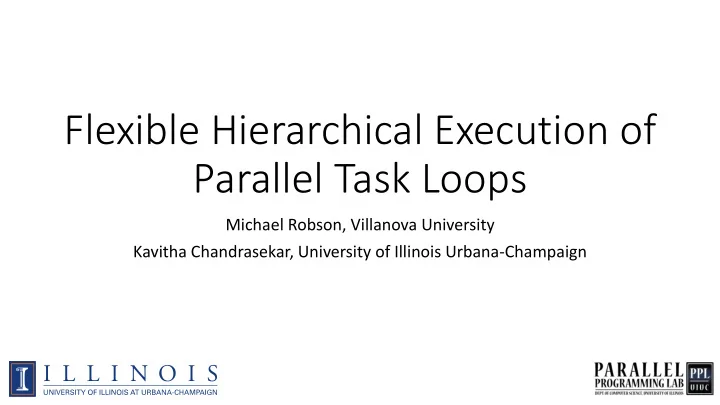

Flexible Hierarchical Execution of Parallel Task Loops Michael Robson, Villanova University Kavitha Chandrasekar, University of Illinois Urbana-Champaign
Injection Bandwidth vs CPU speeds Kale (Salishan 2018) 2
Motivation Year Machine Linpack FLOPs/ FLOPs/ (FLOPs) Local Remote 1988 Cray 2.1 Giga 0.52 0.52 • Trend: YMP • Deeper nodes 1997 ASCI Red 1.6 Tera 8.3 20 2011 Road- 1.0 Peta 6.7 170 • Thinner pipes runner 2012 Sequoia 17 Peta 32 160 • Accelerators (e.g. GPUs) 2013 Titan 18 Peta 29 490 2018 Summit 122 Peta 37 1060 2011 K-Comp 11 Peta 15 95 • Increased Programmer effort 2013 Tianhe-2 34 Peta 22 1500 2016 Sunway 93 Peta 130 1500 2021 TBD 1.0 Exa 80 3200 2021 TBD 1.0 Exa 300 10000 S. Plimpton (Charm ‘19) 3
Fat Nodes First law of holes: • If you find yourself in a hole, stop digging! 1 TF 40 TF We are digging ourselves deeper into a node Kale (Salishan 2018) 4
Main Idea: Spreading Work Across Cores • Speed up individual calculations via OpenMP • FLOPs are cheap, need to inject early • Better communication, computation overlap 5
Overdecomposition Spreading 1 2 4 Cores 0 1 2 3 OpenMP Time 0 Cores Cores Cores 0 1 2 3 0 1 2 3 0 1 2 3 Time Time Time MPI 1 Cores Cores Cores 0 1 2 3 0 1 2 3 0 1 2 3 Charm++ Time Time Time 2 6
Motivation New Axes of Optimization • Problem Size Decomposition (Grain Size) • Resources Assigned to a Task (Spreading) 7
Experimental Setup • Charm Build • Separate processes (Non-SMP mode) • – O3 – with-production • PAMI-LRTS communication layer • Five Runs • OpenMP Threads (Spreading) = 1, 2, etc • Grid Size = 178848 2 doubles (~90%) • Block Size = 7452, various • Chares (Objects) = 24 2 • Iterations = 10-100 • Nodes = 4 8
OpenMP Pragmas • Schedule - Static • Chunk Size (Iterations) • Default (Block / Cores) • 1 • 16 • 512 • Collapse 9
Machines Bridges (PSC) Summit (ORNL) • 2 x 14-core Haswell E5-2695 • 2 x 22-core IBM Power9 • 128 GB DDR4 • 512 GB DDR4 10
Bridges 11
Summit – Block Size 12
Summit 13
Summit – Scaling 14
What happens when we eliminate communication? i.e. are effects just from improved caching? 15
Summit – No Send 16
Lets look at communication performance… using projections. 17
OpenMP Baseline 320K Received bytes per second 240K 160K 80K 0 17.5 21.9 26.3 30.7 35.1 Time (s) 18
Charm++ Baseline 320K Received bytes per second 240K 160K 80K 0 6.8 11.2 15.6 20.0 24.4 Time (s) 19
Spreading Technique 320K Received bytes per second 240K 160K 80K 0 22.4 26.8 31.2 35.6 40.0 Time (s) 20
320K Received bytes per second 240K 160K 80K 0 6.8 11.2 15.6 20.0 24.4 Time (s) 21
Runtime Integration 22
Automating teams configuration • Broader Agenda • Automate decisions -> easier for user • “Spread”: How many teams, i.e how many masters and how many drones? • Other runtime decisions: • How many ppn, i.e cores per process? • How many processes per node? • How many cores to turn off (memory bottleneck)? • Enable SMT or not?
Automating teams configuration • Use OpenMP to create master thread on all cores • Integrate with load balancing framework to change master thread count • Use OpenMP nested parallelism to set/change number of drone threads within the application • Use pthread affinities instead of OpenMP affinity to update configurations at runtime • Runtime selects the best performing configuration after testing with different configurations (one per LB step)
Using OpenMP with nested parallelism (static) Bridges - single-node integrated OpenMP runs for SMP and Non-SMP builds
Using OpenMP with nested parallelism (static) Stampede2 - Skylake 4-node run integrated OpenMP
OpenMP Implementation machine-smp.C jacobi2d.C Static configuration: Dynamic configuration: pthread_setaffinity_np(thread, sizeof(cpu_set_t), &cpuset);
OpenMP implementation with pthread affinity • Similar performance with process- based and OpenMP implementations • Some NUMA effects • OpenMP Limitations: • Nested parallelism configurations Select best cannot be dynamically changed configuration • Affinities are set at the initialization and cannot be changed • With Charm++ we are able to dynamically change OpenMP configurations and with pthread affinity we set affinities for each new configuration
Next steps • Integrate the LB framework to fully automate configuration selection • Current implementation is able to dynamically set different configurations at runtime based on user input • Benefit over static OpenMP configuration – configurations and affinities can be changed at runtime • Compare with CkLoop implementation in Charm++
Summary • Spreading offers new optimization parameter • Increases performance 20-30% in prototype application • Spread factor is controllable at runtime • Current integration into Charm++ ongoing Questions Michael Robson michael.robson@villanova.edu Kavitha Chandrasekar kchndrs2@illinois.edu 30
Recommend
More recommend